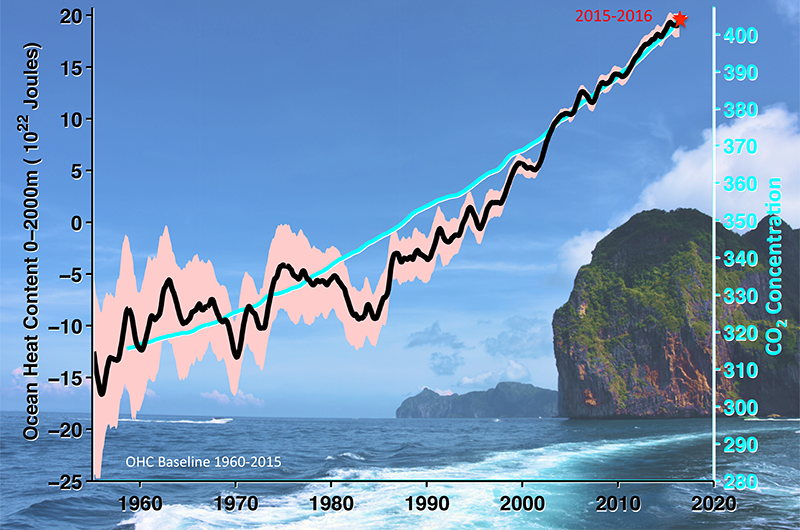How fast is Earth warming? Ocean heat content and sea level rise measurements may provide a more reliable answer than atmospheric measurements.

Fishermen ply their trade in the Gulf of Mannar in the Indian Ocean near Sri Lanka, one example of the vital importance of oceans to planet Earth and humankind. Measurements of ocean heating and sea level rise could prove more reliable than atmospheric measurements for tracking vital signs for the health of the planet. Credit: Jiang Zhu
By Lijing Cheng, Kevin E. Trenberth, John Fasullo, John Abraham, Tim P. Boyer, Karina von Schuckmann, and Jiang Zhu 13 September 2017
Humans have released carbon dioxide and other greenhouse gases in sufficient quantity to change the composition of the atmosphere (Figure 1). The result is an accumulation of heat in Earth’s system, commonly referred to as global warming. Earth’s climate has responded to this influx of heat through higher temperatures in the atmosphere, land, and ocean. This warming, in turn, has melted ice, raised sea levels, and increased the frequency of extreme weather events: heat waves and heavy rains, for example. The results of these weather events include wildfires and flooding, among other things [Intergovernmental Panel on Climate Change, 2013].

Fig. 1. Ocean heat content (OHC) and atmospheric carbon dioxide (CO2) concentration measurements since 1958, shown as 12-month running means. The black line represents ocean heating for the upper 2,000 meters of ocean, and light red shading represents the 95% confidence interval. CO2 concentration observed at Mauna Loa Observatory is displayed by light blue. Mean values for 2015–2016 are highlighted with a red star. The OHC is relative to a 1960–2015 baseline. Ocean heat data are from Cheng et al. [2017], and CO2 information is from the National Oceanic and Atmospheric Administration.
Decision-makers, scientists, and the general public are faced with critical questions: How fast is Earth’s system accumulating heat, and how much will it warm in the future as human activities continue to emit greenhouse gases?
Ocean heating and sea level rise show stronger evidence that the planet is warming than does global average surface temperature, which relies on air temperature measurements.
Here we explore better ways of measuring global warming to answer these questions. Natural temperature variability is much more muted in the ocean than in the atmosphere, owing to the ocean’s greater ability to absorb heat (its heat capacity). As a result, ocean heating and sea level rise, which are measured independently, show stronger evidence that the planet is warming than does global average surface temperature, which relies on air temperature measurements. In other words, these ocean measurements could provide vital signs for the health of the planet.
Thus, we suggest that scientists and modelers who seek global warming signals should track how much heat the ocean is storing at any given time, termed global ocean heat content (OHC), as well as sea level rise (SLR). Similar to SLR, OHC has a very high signal-to-noise ratio; that is, it clearly shows the effects of climate change distinct from natural variability.
Authors Information:
Lijing Cheng (@Lijing_Cheng), International Center for Climate and Environment Sciences, Institute of Atmospheric Physics, Chinese Academy of Sciences, Beijing; Kevin E. Trenberth (email: trenbert@ucar.edu) and John Fasullo (@jfasullo), National Center for Atmospheric Research, Boulder, Colo.; John Abraham, University of St. Thomas, St. Paul, Minn.; Tim P. Boyer, National Centers for Environmental Information, National Oceanic and Atmospheric Administration, Silver Spring, Md.; Karina von Schuckmann, Mercator Océan, Ramonville St Agne, France; and Jiang Zhu, International Center for Climate and Environment Sciences, Institute of Atmospheric Physics, Chinese Academy of Sciences, Beijing
Citation:
Cheng, L., K. E. Trenberth, J. Fasullo, J. Abraham, T. P. Boyer, K. von Schuckmann, and J. Zhu (2017), Taking the pulse of the planet, Eos, 98, https://doi.org/10.1029/2017EO081839. Published on 13 September 2017.
